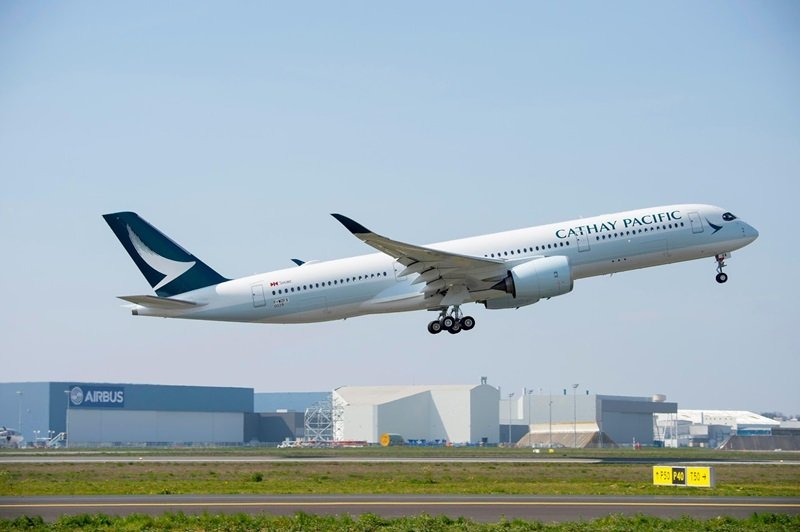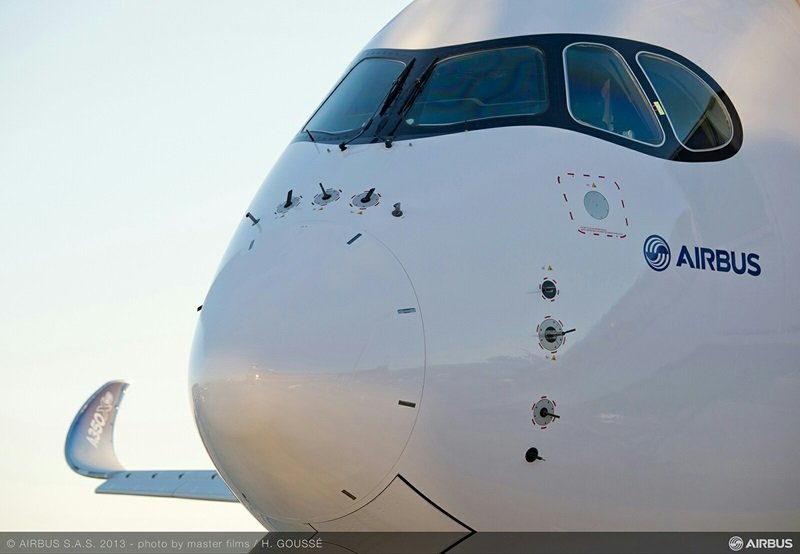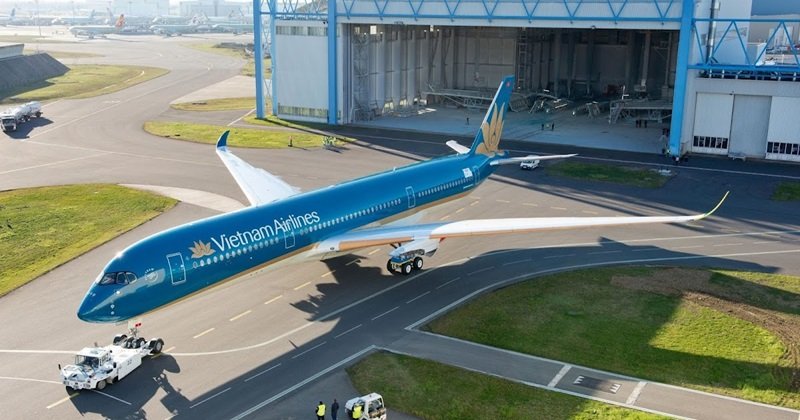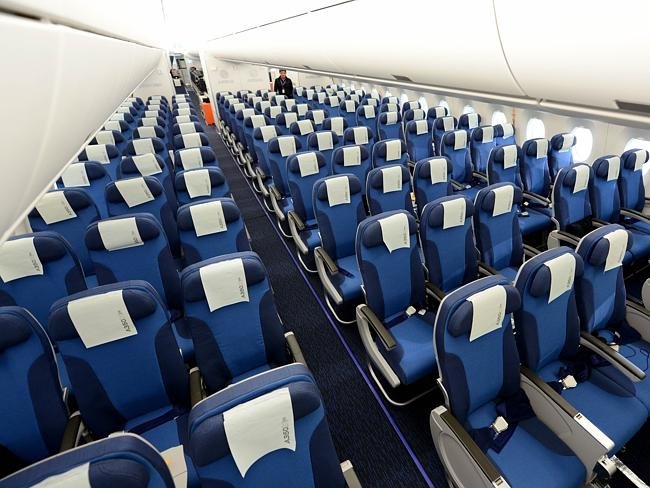
Airbus A350 XWB.
SPECS
ASSEMBLY
INTERIOR
HISTORY
ORDERS
Airbus A350 in Airbus house colours lands
The Airbus A350 is Airbus' latest offering to the passenger air transport market. It is a mid-sized twin-engined wide-body airliner that comes in 3 variants, A350 800, A350 900, and A350 1000. When we say wide body, the XWB in the name actually stands for eXtra Wide Body. Visit our A350 Specs section below to see the actual dimensions.
The remarkable thing about this airliner is the steps forward it represents in technology improvements. Its construction involves the use of new composite materials as well as new construction methods. This is a very similar direction taken by Boeing with their Boeing 787 Dreamliner.
One could be forgiven for seeing the mid-size passenger jet market as a Boeing 787 vs Airbus A350 competition.
The quest for technological improvements is all around us, and not least of those are the improvements in the aviation field. To the travelling public, some of those have been less obvious perhaps, other than new and better in-flight entertainment options. We are about to enter an age of new ways in the sky.
Airbus has shown us new ways of construction with the introduction of the Airbus A380 Super-Jumbo, with its carbon polymer wing construction. Boeing has at last brought to market its all-new Boeing 787 Dreamliner, with radical improvements in construction techniques as well as materials used.
A Singapore Airlines A350-900 on its ferry flight to Singapore.
Today's economic climate is driving the need for reduced operating costs, and airlines are very vocal in their pressure on aircraft manufacturers to deliver a more cost-effective product, as well as one that complies with stricter noise reduction requirements at our urban airports.
The process of bringing a new aircraft design to fruition is a long and torturous path as well as hugely expensive. The new Airbus A350 XWB (Extra Wide Body) family of aircraft is no different. Airbus, like Boeing, was being pressured to produce a new offering using newer technology in materials and construction to produce a product that would reduce their airline customers’ overhead costs.
Airbus floated the idea initially of using their existing and popular Airbus A330 twin-engine mid-sized jet and re-engineering it using new materials and construction methods. They were very quickly told by prospective customers that this would not be enough. The Airbus A350 History page gives more details, however, in short, Airbus went away and sharpened their pencils, committed more development funds and the result that has been fixed on and widely accepted by customers is the A350 XWB family of aircraft.
The Airbus A350 XWB could be seen as a knee-jerk reaction to the Boeings 787 Dreamliner, however, the longer A350 1000 XWB is also a direct competitor to Boeings' popular 777, as well as a replacement for the Airbus discontinued A340 series.
The A350 assembly process is the result of significant investment by Airbus in new plant as well as newly forged relationships with outside suppliers.
New concepts in aero technology bring with them new challenges in manufacturing and also opportunities to review current concepts. The Airbus A350 XWB has benefited from new ways of improving processes which reduce production time and therefore expenses.
Airbus Industrie has invested significant capital in the creation of ten new factories in Europe and in the US for the A350 assembly. In addition, extensions have been carried out on three other sites.
As well as significant investment, international collaboration has been sought with many big-name suppliers, and also national bodies to bring together the Airbus A350 XWB.
ASSEMBLY
A350 Parts Manufacturers.
Avionics: As with many Airbus models, Thales will be providing the avionics.
Cabin Ergonomics and Interior Concept: BMW
Engines: Rolls Royce will be providing the Trent XWB engines for all three A350 variants.
Fuel Systems: Parker Hannifin.
Fuselage: Constructed in Illescas, Spain.
Horizontal Stabiliser Actuator: Rockwell Collins, USA.
In-flight Communications and Entertainment: Panasonic Avionics Corporation.
Airbus A350 fuselage sections near time to marry together.
Main undercarriage: Messier-Dowty, France.
Nose gear: Liebherr-Aerospace.
Primary Flight Control Actuators: Moog Inc.
Rudder: Construction plant in China, Airbus uses new methods which will cut the production time in half.
Thrust Reversers and Engine Nacelles: These will be provided by Goodrich Corporation, USA.
Wings: Constructed in a new building in Broughton, Wales, where some EUR745 was spent on construction. The National Assembly for Wales provided UKL28 toward the facility where the new generation composite wings would be constructed.
Airbus A350 parts such as fuselages and wings are transported between factories by Super Beluga, which is a converted Airbus A300-600 aircraft.
The first Airbus A350 XWB model, airframe MSN001, rolls out of the factory destined for the paint shop.
SPECIFICATIONS
Airbus is producing three variants of the A350, namely the Airbus A350 800, Airbus A350 900, and the Airbus A350 1000. Building on technologies from the Airbus A380, the Airbus A350 XWB has the same fly-by-wire technology as well as a similar cockpit layout to the Super Jumbo.
The use of new materials and manufacturing methodology produces in the region of a 10% reduction in maintenance costs as well as a 14% reduction in empty weight per seat compared to competitors.
To put things in perspective the use of modern materials between the Airbus A350 XWB and its most similar competitor, the Boeing 787 read as follows:
Airbus A350 wet runway water test.
Comparative use of composite materials.
| Material | Airbus A350-XWB | Boeing 787 |
|---|---|---|
| Composites | ||
| Aluminium, Aluminium-Lithium (Alu-Li) | ||
| Titanium | ||
| Steel | ||
| Miscellaneous |
The new design makes it possible to pressurise the cabin to the equivalent of pressure found at 6,000 feet (1,800 metres), with humidity at 20%. The use of composites allows for higher humidity without the risk of corrosion. The new airflow system is able to adapt to passenger numbers and adjusts accordingly with a draught-free flow.
The fuselage has a constant diameter from door 1 to door 4 thereby not only maximising space available inside the aircraft but standardising all doors so that not so many spare parts have to be carried.
The fuselage, as the designator XWB (Extra Wide Body) would indicate, is remarkable in that it is wider than both the A330 and A340 models. The A350 XWB has an external cabin width of 5.97 metres (19.6 feet) against the A330/A340 at 5.64 metres (18.5 feet).
Airbus A350-900 Reg F-WXWB prototype showing off the wing configuration during landing.
The redesigned wing is the largest for a wide body single deck aircraft and is common to all three variants measuring 443 square metres (4,770 square feet). The wing sweep is 31.9 degrees for a span of 64.8 metres (213 feet) which is the same as Boeing 777-200LR / 777-300ER, although the Boeing aircraft have slightly less area.
Gone are the traditional Airbus wingtip fences, to be replaced with a sabre like point taking up the outer 4.4 meters (14 feet) of the wing. The high-lift trailing edge of the wing uses the same hinge system as the A380 with spoilers covering the gap created when flaps are extended. The new wing design allows a cruising speed of mach .85 with a maximum operating speed of mach .89.
Cockpit windshields on the A350.
The nose section uses a similar design criterion to the Airbus A380, offering improved aerodynamics. The nose wheel is forward swinging as does the Airbus A380. The shape of the forward section allows a crew rest area to be placed further forward above the cabin ceiling which reduces its encroachment on the passenger cabin space.
A trade-off study was conducted to determine the best construction material for the forward section. Composite materials would have been an obvious choice due to weight benefits, however, extra strength is required to allow for bird strikes and if composites were employed then extra titanium would be required to bolster the strength. The decision was made to go with aluminium.
Instead of the traditional 4 flight deck windows, A350 XWB has 6 giving not only a wider field of vision but also with the spread of the load carried by the window posts the centre post can be thinner improving forward vision.
The A350 XWB cockpit carries 6 LCD screens of a 38cm (15in) diameter. Two are located in the centre of the panel one above the other above the thrust levers. Each pilot has their own primary, flight and navigation panels. The system is designed to allow for the addition of new technology as it comes in the future.
Pilots also benefit from a Head Up display (HUD), where primary information is projected onto a clear screen in their forward line of sight much like fighter pilots so that they never have to take their eyes off the outside world.
The Integrated Modular Avionics (IMA) found on the A380 have been improved upon with the system handling 40 functions against the A380s 23. These include functions such as; Undercarriage, air systems, pneumatics and fuel. The benefits, of course, will be weight reduction as fewer processors are required on board, as well as a more stable system running a 100 Megabit per second network.
Cockpit of A350 XWB showing the large LCD screens .
There are two Trent XWB engines to provide power to all A350 XWB variants. Details can be found in the table further down this page.
Advanced technology gained on the creation of the Trent 900 for the A380 and Trent 1000 for the Boeing 787 will obviously benefit the A350 XWB. In addition, the advances in noise dampening ensure that A350 XWB has state-of-the-art solutions.
Airbus has adopted a three-prong main landing gear configuration with the two main prongs attached to the rear wing spar forward and to a gear beam to the rear which is itself attached to the wing and fuselage. The use of composite materials in wing construction requires a more even distribution of weight. The main gear comes in four and six-wheel bogies. Four for the -800 and -900 variants and six for the heavier longer range -1000 and also the -900r being proposed for British Airways to enable a London to Sydney non-stop type range.
An example of the 4-wheel main landing gear bogie on an Airbus A350-941, Reg F-WWCF Airframe MSN002 at ILA Berlin June 2016
Airbus A350 XWB Specs Table
| A350-800 | A350-900 | A350-1000 | |
|---|---|---|---|
| Range | 15,700Km (8,300NM) | 15,000Km (8,100NM) | 15,600Km (8,400NM) |
| Seating (Typical) | 270 | 314 | 350 |
| Replaces Current Model | A330-200 | A340-300 | A340-600 |
| Listed Airbus A350 Price | US$269.5 Million | US$304.8 Million | US$351.9 Million |
| Competes against | Boeing 787-9 | Boeing 777-200ER | Boeing 777-300ER |
| Length | 60.54 Metres | 66.89 Metres | 73.88 Metres |
| Wing span | 64.75 Metres | 64.75 Metres | 64.75 Metres |
| Height | 17.10 Metres | 17.10 Metres | 17.10 Metres |
| Fuselage Width (Exterior) | 5.96 Metres | 5.96 Metres | 5.96 Metres |
| Cabin width (Interior) | 5.61 Metres | 5.61 Metres | 5.61 Metres |
| Track | 10.60 Metres | 10.60 Metres | 10.70 Metres |
| Wheelbase | 24.86 Metres | 28.67 Metres | 33.10 Metres |
| Freight (underfloor) LD3 | 28 | 36 | 44 |
| Freight (underfloor) Pallets | 9 | 11 | 14 |
| Freight (underfloor) Bulk | 11.3 Cubic Metres | 11.3 Cubic Metres | 11.3 Cubic Metres |
| Freight (underfloor) Total | 136.6 Cubic Metres | 172.3 Cubic Metres | 208.1 Cubic Metres |
| Maximum Operating Speed | Mach 0.89 | Mach 0.89 | Mach 0.89 |
| Maximum Ramp Weight | 248.9 tonnes | 268.9 tonnes | 308.9 tonnes |
| Maximum Take off Weight | 248.0 tonnes | 268.0 tonnes | 308.0 tonnes |
| Maximum Landing Weight | 190.0 tonnes | 205.0 tonnes | 233.0 tonnes |
| Maximum Zero Fuel Weight | 178.0 tonnes | 192.0 tonnes | 220.0 tonnes |
| Maximum Fuel Capacity | 138,000 Litres | 138,000 Litres | 156,000 Litres |
| Engines - Rolls Royce Trent XWB | RR Trent XWB 337kN (74,000 LBF) | RR Trent XWB 374kN (83,000 LBF) | RR Trent XWB 432kN (97,000 LBF) |
| Average unit price in USD millions. | 260.9 | 295.2 | 340.7 |
When Boeing announced the development of the Boeing 787 Dreamliner, Airbus didn't immediately respond as they took this to be Boeings' reaction to the Airbus A330. When it became evident that the Boeing 787 would be a far more advanced aircraft in its systems and use of composite materials, Airbus proposed a modernisation of the Airbus A330.
This would have been called the A330 200 Lite with redesigned wings and engines of the new generation as offered by the Boeing 787.
This offering was nipped in the bud very quickly by Airbus prospective customers and was never announced at the Farnborough Airshow in 2004 as intended. They demanded an all new aircraft, a completely new design from the ground up.
History.
Airbus A350-900 of Qatar Airways on approach for landing at Frankfurt
Airbus A350 History Timeline.
16 September 2004: Noel Forgeard, Airbus President and CEO, intimated that a new project was under consideration but failed to give a name to it. No clarity was given as to whether this was to be a derivative design or a clean slate new concept design. Airbus customers were clearly not satisfied, so Airbus committed EUR4 Billion to the new A350 project. Still resembling the A330, particularly the fuselage, the new design incorporated new wings and horizontal stabilisers, as well as new composite materials and manufacturing methodology. Essentially it was a new aircraft design now.
10 December 2004: The EADS board as well as the BAe board, who were at that time shareholders of Airbus, voted to give Airbus an Authorisation To Offer (ATO), and gave the designation of A350.
16 June 2005: At the Paris Airshow, Qatar Airways places an order for 60 Airbus A350 XWB aircraft.
Finnair A350 on First Flight in Toulouse.
06 October 2005: Airbus officially began the industrial launch of the project with an estimated development cost of EUR3.5 Billion. The design was for a twin-engine wide-body jet capable of seating 250 to 300 passengers in a fuselage that was still very similar to that of the A330. Wings and engines were to be redesigned but the construction would still be aluminium-lithium (Al-Li) as opposed to the carbon-fiber-reinforced polymer (CFRP) used on the Boeing 787.
Airbus would offer two versions of the A350:
-The A350-800 would be capable of flying 8,800 nm (16,300 km) with a typical passenger load of 253 in a 3-class configuration.
-The A350-900 would be capable of flying 7,500 nm (13,900 km) with a typical passenger load of 300 in a 3-class configuration
This ensured that Airbus addressed competition with both the Boeing 777-200ER and Boeing 787-9.
Airbus A350 Airframe MSN3 conducting cold weather tests at Iqaluit Canada.
28 March 2006: Airbus was severely taken to task by International Lease Finance Corporation (ILFC), GE Capital Aviation Services (GECAS), Singapore Airlines and many other industry heavyweights over their proposed A350. It was seen as a knee-jerk reaction to the Boeing 787 and this could only lead to a loss of market share to Boeing who was seen to be leading the technology charge. CEO Gustav Humbert indicated that Airbus was not looking for quick solutions and was looking for solutions, not for the short term but ones that would take aviation into the future.
14 July 2006: Once again at the Farnborough Airshow Airbus announced the new completely redesigned aircraft would be designated the Airbus A350 XWB (Extra Wide Body). There was a rumour that the new aircraft would be designated the A370 or even the A280. This could have been fueled by an erroneous advertisement run by Airbus on the Financial Times website. Within a few days, an order was placed by Singapore Airlines for 20 of the new jet with options for 20 more. Airbus received accolades for coming up with a completely new design for the A350.
September 2006: Qatar Airways signs with General Electric to provide the GEnx-1A-72 for the Airbus Industries A350 XWB.
A Vietnam Airlines A350-900 rolls out of the paint shop.
01 December 2006: Delays with the Airbus A380 program meant that the board of Airbus did not finally approve the development of the A350 until this date. Airbus resources were very stretched at this time and the go-ahead was still not a certainty. Finally, the decision was reached to fund the development from cash flow, and the go-ahead was given for the first delivery of the A350 900 XWB in mid-2013, the first A350 800 XWB in 2014 and the A350 1000 XWB in 2015.
04 December 2006: Some new details of the design were released to the public. It was also revealed that re-negotiations were taking place with existing order holders due to the increased cost of the redesigned A350 XWB.
04 January 2007: Airbus announces that a firm order for 2 aircraft had been placed by Pegasus Aviation Finance Company.
The change to the design of the A350 XWB caused an extra two years to be added to the development program. As a result, the estimated development costs doubled from EUR5.5 Billion to almost EUR10 Billion. Airbus stressed that the first delivery dates would remain unchanged, however, the first flights would be delayed. The testing program would be reduced from 15 months to 12 months.
A350-900 test aircraft honouring launch customer Qatar.
September 2007: At a gathering of around 100 existing and potential customers of the A350, Airbus presented the design advances of the new aircraft.
January 2008: Thales Group wins the contract to provide avionics for the A350, a EUR2 Billion contract over 20 years.
12 November 2010: Airbus announces that the first delivery date would slip from mid-2013 to late 2013 due to the complexities of moving from the design to manufacturing phases.
29 December 2011: The first forward fuselage section was delivered to the factory.
05 April 2012: Construction and assembly of the first static A350 model is started.
Airbus A350 XWB in Airbus house colours landing.
14 June 2013: Maiden flight of the A350. At Toulouse-Blagnac airfield with thousands of spectators and Airbus employees looking on, the A350 XWB made its maiden flight. The four-hour flight was undertaken by a team of six wearing orange jumpsuits and parachutes flying over the Pyrenees Mountains.
Chief Test Pilot Peter Chandler reported from 13,000 feet that the aircraft was handling extremely well. Much of the testing was focused on the flaps and landing gear. The first stage of the flight was conducted with the landing gear extended.
The timing of the maiden flight was no accident with the Paris Airshow set to begin on Monday 17 June. Airbus now had the maiden flight under its belt as it prepared to go head-to-head with the Boeing 787. The order book for the A350 stood at 616, which included an order for 50 units from Singapore Airlines received during this month.
Airbus A350 XWB airframe MSN 005 registration F-WWYB showing off the sabre wing tip.
21 June 2013: Toward the end of its third test flight, the aircraft with in-house designation MSN1 made its first public appearance when it made a show-stopping entrance at the Paris Airshow around 13:30. The A350 XWB made a pass down the Le Bourget main show runway to thunderous applause from the crowd. The aircraft then gracefully climbed into the cloud and was gone.
29 July 2013: A virtual commercial flight of 5 hours was conducted on the ground in Hamburg. 129 passengers, 2 pilots and 8 cabin crew took part in em-planing, deplaning and normal in-flight activities as part of early testing of the human factors of flight.
14 October 2013: The second A350 XWB test aircraft with in-house designator MSN3 took to the skies from Toulouse-Blagnac Airport France at around 14:30. Like MSN 1 the aircraft was devoid of a cabin interior but carried heavy testing equipment instead.
A350-900 China Airlines Toulouse Blagnac.
22 December 2014: Qatar Airways, the launch customer for the A350 XWB took delivery of their first Qatar A350.
15 January 2015: The first commercial service of the Airbus Industrie Airbus A350 XWB was flown from Doha to Frankfurt.
25 September 2015: Construction starts on the first A350 1000.
24 November 2016: The A350 1000 stretched version takes to the air for its maiden flight at 10:42 am from Toulouse Le Blagnac airfield. The test flight lasted just over four hours and began the giant A350's rigorous certification program.
21 November 2017: In just under a year since her maiden flight the Airbus A350-1000 gained type certification from both the F.A.A. (Federal Aviation Authority of the U.S.A.) and European Aviation Safety Agency (E.A.S.A.). At the time of this event, the A350-1000 had orders from 11 customers for a total of 169 airframes.
Airbus A350 XWB Carbon Livery.
Cabin Interior.
The focus of the Airbus A350 XWB for the travelling public is the concept of space. With a wider fuselage than other aircraft in its class, the A350 is able to offer a wider seat than the Boeing 787 by 1.3cm (0.5in) in a similar configuration. The distance between outside armrests is 220 inches which is 5 inches greater than the nearest competitor. This allows for a very luxurious space for First and Business class travellers as well as those in economy class in a nine-seat abreast configuration.
Some Airbus A350 example cabin layouts.
Airbus A350 XWB Business class option.
Airbus A350 XWB Business class option.
The fuselage of the A350 XWB is a constant width between doors 1 to 4, which maximises the usability of space within the cabin allowing the full width of seating to apply to the whole cabin. If you look at the cabin profile head-on, it is an ovoid shape, pressed into flatness around the window area. This adds to the feeling of space with more headroom, and also larger baggage storage space in the overhead lockers.
Airbus A350 XWB interior economy cabin 9 abreast facing rearwards..
Airbus A350 XWB interior economy cabin 9 abreast facing forewards..
The feeling of space is further enhanced by the size of the windows which are wider than competitors providing more of a panoramic view, and enabling those passengers not in window seats to also see outside. The new materials and construction methods will enable the cabin to be pressurised to the equivalent pressure found at around 6,000 feet of altitude. Passengers will also arrive more refreshed as an average humidity of 20% can be maintained.
As well as a crew rest area in the ceiling just behind the flight deck for flight crew, there is also one for cabin crew located in the tail which can accommodate six to eight bunks. The area will provide a space to stand at full height to enable easy dressing.
Some Airbus A350 XWB example cabin configurations.
Business Class
Long Haul - Six abreast.
Short to Medium Haul - Seven abreast.
Premium Economy - Eight abreast.
Economy Class
Economy - Nine abreast.
High-Density Economy - Ten abreast.
Orders and Deliveries.
For each new aircraft model that is brought to production, a launch airline customer must be found. This can be a complex arrangement and relationship as the airline wants to produce an aircraft that is as attractive to the general market as possible.
The launch airline has extensive input into the finished product while at the same time being able to negotiate a favourable price for their order. The risk, and therefore the reason that the launch carrier can negotiate such a favourable unit price for their order is that there can be delays. The Airbus A350 XWB is no different. New technology and so far untried new methods can lead to delays when things don't go to plan. A very obvious example of this was the launch of the Boeing 787 Dreamliner which ran into all sorts of problems and led to extensive delays.
Qatar Airways was the launch customer for two variants of the A350. The first of course was the A350-900 which was delivered on 22 December 2014. This was followed by the A350-1000 which was delivered on 20 February 2018. This A350-1000 was the first to be fitted with the revolutionary new Qsuite seats, a new innovation in Business Class seat that makes up into a double bed.
Orders and Deliveries Summary
| A350-F | A350-900 | A350-1000 | Totals | |
|---|---|---|---|---|
| Orders | 31 | 748** | 140 | 888 |
| Deliveries | - | 442** | 67 | 509 |
| Operational | - | 442 | 67 | 509 |
Correct to end November 2022
**excludes 2 A350-900 delivered to ITA AIRWAYS via AIRBUS FINANCIAL SERVICES
**excludes 2 A350-900 AEROFLOT under sanctions
Airbus A350 Order Book.
Correct as at end of November 2022.
| A350-F | A350-900 | A350-1000 | ||||||||||
|---|---|---|---|---|---|---|---|---|---|---|---|---|
| ORD | DEL | OP | ORD | DEL | OP | ORD | DEL | OP | ||||
| Govt. Exec and Private Jets | 5 | 4 | 4 | |||||||||
| Aercap (leasing) | 20 | 20 | ||||||||||
| Aeroflot | 16 | 7 | 4 | |||||||||
| Afriqiyah Airways | 10 | |||||||||||
| Air Caraibes | 3 | 4 | 2 | 3 | ||||||||
| Air China | 30 | 20 | 20 | |||||||||
| Air France | 4 | 38 | 20 | 20 | ||||||||
| Air Lease Corporation | 7 | 18 | 13 | 8 | 6 | |||||||
| Air Mauritius | 4 | 2 | 4 | |||||||||
| Alafco | 12 | 12 | ||||||||||
| A350-F | A350-900 | A350-1000 | ||||||||||
| ORD | DEL | OP | ORD | DEL | OP | ORD | DEL | OP | ||||
| Asiana Airlines | 30 | 13 | 13 | |||||||||
| Azul | 4 | |||||||||||
| BOC Aviation | 2 | 2 | ||||||||||
| British Airways | 18 | 13 | 13 | |||||||||
| Cathay Pacific | 28 | 26 | 28 | 18 | 17 | 17 | ||||||
| China Airlines | 14 | 14 | 14 | |||||||||
| China Eastern | 20 | 14 | 14 | |||||||||
| China Southern Airlines | 20 | 15 | 16 | |||||||||
| C.I.T. Leasing | 7 | 7 | ||||||||||
| CMA CGM | 4 | |||||||||||
| DAE Capital | 2 | 2 | ||||||||||
| Delta Airlines | 25 | 18 | 27 | |||||||||
| Emirates | 50 | |||||||||||
| Ethiopian Airlines | 18 | 17 | 19 | 4 | ||||||||
| Etihad Airlines | 7 | 20 | 5 | 5 | ||||||||
| Evelop Airlines | 2 | |||||||||||
| Fiji Airways | 2 | |||||||||||
| Finnair | 19 | 17 | 17 | |||||||||
| French BEE | 4 | 1 | ||||||||||
| GROUPE DUBREUIL | 1 | 1 | ||||||||||
| Hainan Airlines | 7 | |||||||||||
| Hong Kong Airlines | 3 | 3 | 2 | |||||||||
| Iberia | 20 | 15 | 15 | |||||||||
| A350-F | A350-900 | A350-1000 | ||||||||||
|---|---|---|---|---|---|---|---|---|---|---|---|---|
| ORD | DEL | OP | ORD | DEL | OP | ORD | DEL | OP | ||||
| Iran Air | 16 | |||||||||||
| ITA Airways | 4 | |||||||||||
| Japan Airlines | 18 | 16 | 16 | 13 | ||||||||
| Kuwait Airways | 2 | |||||||||||
| Latam Airlines Group | 13 | 13 | ||||||||||
| Libyan Airlines | 6 | |||||||||||
| Lufthansa | 45 | 17 | 21 | |||||||||
| Malaysia Airlines | 6 | |||||||||||
| Philippine Airlines | 6 | 6 | 2 | |||||||||
| QANTAS Airways | 12 | |||||||||||
| Qatar Airways | 34 | 34 | 34 | 19 | 19 | 19 | ||||||
| Scandinavian Airlines | 8 | 6 | 6 | |||||||||
| Sichuan Airlines | 10 | 1 | 4 | |||||||||
| Silk Way West Airlines | 2 | |||||||||||
| Singapore Airlines | 7 | 65 | 61 | 61 | ||||||||
| Sri Lankan Airlines | 4 | |||||||||||
| Starlux | 17 | 1 | 1 | |||||||||
| Thai International | 4 | 4 | 12 | |||||||||
| Turkish Airlines | 26 | 11 | 11 | |||||||||
| United Airlines | 45 | |||||||||||
| Vietnam Airlines (Aercap) | 10 | 10 | 14 | |||||||||
| Virgin Atlantic | 8 | 5 | 9 | |||||||||
| World2fly | 2 | |||||||||||
| Yemenia Yemen Airways | 10 | |||||||||||
| Undisclosed | 13 | 9 | ||||||||||
| Totals | 31 | 748 | 442 | 442 | 140 | 67 | 67 | |||||
| ORD | DEL | OP | ORD | DEL | OP | ORD | DEL | OP | ||||
| A350-F | A350-900 | A350-1000 | ||||||||||
On 22 December 2014 Qatar Airways took delivery of the world's first A350XWB. After a handover ceremony in Toulouse, France the first production Airbus A350 XWB departed on its ferry flight to Doha in the company of Qatar's fourth Airbus A380. Qatar is now the only airline in the world to fly every aircraft family produced by Airbus. The Qatar A350 commenced commercial services in January 2015 on the Doha to Frankfurt route.





































